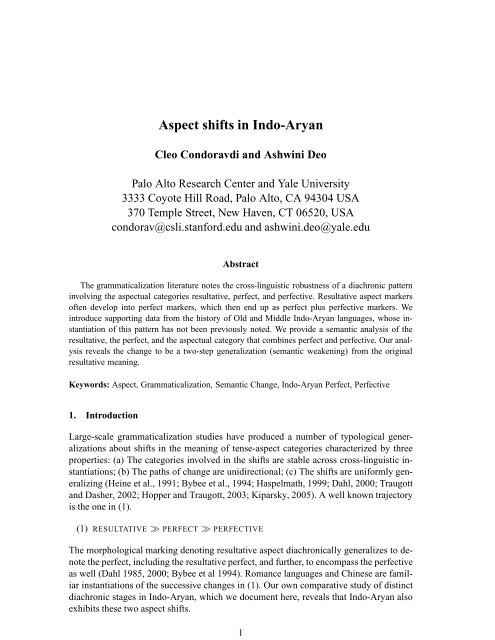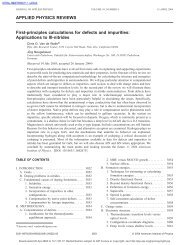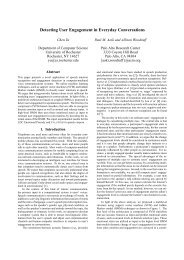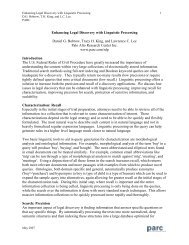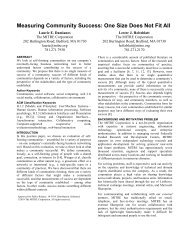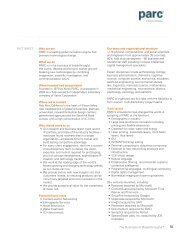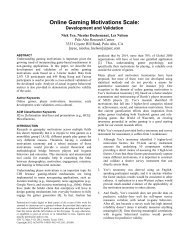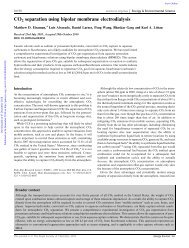download PDF - Aspect shifts in Indo-Aryan - Parc
download PDF - Aspect shifts in Indo-Aryan - Parc
download PDF - Aspect shifts in Indo-Aryan - Parc
Create successful ePaper yourself
Turn your PDF publications into a flip-book with our unique Google optimized e-Paper software.
<strong>Aspect</strong> <strong>shifts</strong> <strong>in</strong> <strong>Indo</strong>-<strong>Aryan</strong><br />
Cleo Condoravdi and Ashw<strong>in</strong>i Deo<br />
Palo Alto Research Center and Yale University<br />
3333 Coyote Hill Road, Palo Alto, CA 94304 USA<br />
370 Temple Street, New Haven, CT 06520, USA<br />
condorav@csli.stanford.edu and ashw<strong>in</strong>i.deo@yale.edu<br />
Abstract<br />
The grammaticalization literature notes the cross-l<strong>in</strong>guistic robustness of a diachronic pattern<br />
<strong>in</strong>volv<strong>in</strong>g the aspectual categories resultative, perfect, and perfective. Resultative aspect markers<br />
often develop <strong>in</strong>to perfect markers, which then end up as perfect plus perfective markers. We<br />
<strong>in</strong>troduce support<strong>in</strong>g data from the history of Old and Middle <strong>Indo</strong>-<strong>Aryan</strong> languages, whose <strong>in</strong>stantiation<br />
of this pattern has not been previously noted. We provide a semantic analysis of the<br />
resultative, the perfect, and the aspectual category that comb<strong>in</strong>es perfect and perfective. Our analysis<br />
reveals the change to be a two-step generalization (semantic weaken<strong>in</strong>g) from the orig<strong>in</strong>al<br />
resultative mean<strong>in</strong>g.<br />
Keywords: <strong>Aspect</strong>, Grammaticalization, Semantic Change, <strong>Indo</strong>-<strong>Aryan</strong> Perfect, Perfective<br />
1. Introduction<br />
Large-scale grammaticalization studies have produced a number of typological generalizations<br />
about <strong>shifts</strong> <strong>in</strong> the mean<strong>in</strong>g of tense-aspect categories characterized by three<br />
properties: (a) The categories <strong>in</strong>volved <strong>in</strong> the <strong>shifts</strong> are stable across cross-l<strong>in</strong>guistic <strong>in</strong>stantiations;<br />
(b) The paths of change are unidirectional; (c) The <strong>shifts</strong> are uniformly generaliz<strong>in</strong>g<br />
(He<strong>in</strong>e et al., 1991; Bybee et al., 1994; Haspelmath, 1999; Dahl, 2000; Traugott<br />
and Dasher, 2002; Hopper and Traugott, 2003; Kiparsky, 2005). A well known trajectory<br />
is the one <strong>in</strong> (1).<br />
(1) RESULTATIVE ≫ PERFECT ≫ PERFECTIVE<br />
The morphological mark<strong>in</strong>g denot<strong>in</strong>g resultative aspect diachronically generalizes to denote<br />
the perfect, <strong>in</strong>clud<strong>in</strong>g the resultative perfect, and further, to encompass the perfective<br />
as well (Dahl 1985, 2000; Bybee et al 1994). Romance languages and Ch<strong>in</strong>ese are familiar<br />
<strong>in</strong>stantiations of the successive changes <strong>in</strong> (1). Our own comparative study of dist<strong>in</strong>ct<br />
diachronic stages <strong>in</strong> <strong>Indo</strong>-<strong>Aryan</strong>, which we document here, reveals that <strong>Indo</strong>-<strong>Aryan</strong> also<br />
exhibits these two aspect <strong>shifts</strong>.<br />
1
The trajectory <strong>in</strong> (1) naturally gives rise to three questions: What is the semantic content<br />
of the resultative, the perfect, and the perfective categories? What logical relation <strong>in</strong><br />
the mean<strong>in</strong>gs of these categories allows the construal of these <strong>shifts</strong> as generalizations?<br />
What is the motivation for the shift from one stage to the next? In this paper we answer<br />
the first two of these questions through a close exam<strong>in</strong>ation of the <strong>Indo</strong>-<strong>Aryan</strong> diachronic<br />
facts. Our analysis of the mean<strong>in</strong>g of the resultative, the perfect, and the perfective enables<br />
an analysis of the diachronic pattern as a two-step generalization (semantic weaken<strong>in</strong>g)<br />
from the orig<strong>in</strong>al resultative mean<strong>in</strong>g.<br />
Although the perfect to perfective shift has been taken to <strong>in</strong>volve semantic bleach<strong>in</strong>g<br />
with an extension <strong>in</strong> the range of uses across time (Schwenter, 1994; Schwenter and Cacoullos,<br />
2008; Bybee et al., 1994, a.o.), this extension has not been explicitly treated as<br />
a systematic generalization. Specifically, previous accounts are compatible with an ambiguous<br />
mean<strong>in</strong>g for the forms that participate <strong>in</strong> the grammaticalization shift. The precise<br />
mechanism which <strong>in</strong>troduces this ambiguity between perfect and perfective mean<strong>in</strong>g<br />
is left unspecified. The generalization analysis we propose is the first explicit proposal to<br />
our knowledge for the resultative to perfect and perfect to perfective <strong>shifts</strong>.<br />
In Section 2 we describe the three dist<strong>in</strong>ct stages of <strong>Indo</strong>-<strong>Aryan</strong> with reference to the<br />
chang<strong>in</strong>g mean<strong>in</strong>g of an orig<strong>in</strong>ally (result) stative morphology, -ta, and establish that it<br />
systematically undergoes the resultative to perfect to perfective shift, a fact gone largely<br />
unnoticed <strong>in</strong> the vast literature on <strong>Indo</strong>-<strong>Aryan</strong>. In Section 3 we characterize the mean<strong>in</strong>gs<br />
of the aspectual operators that are <strong>in</strong>volved <strong>in</strong> the analysis of -ta across the del<strong>in</strong>eated<br />
stages. The first diachronic generalization effects a change such that one of the entailments<br />
of the resultative, namely that of the prior occurrence of an event of the type denoted<br />
by the lexical predicate, becomes part of the mean<strong>in</strong>g of the operator at a later stage<br />
(the perfect stage). The second diachronic generalization associates with the aspectual<br />
operator a more general relation for <strong>in</strong>stantiat<strong>in</strong>g eventuality descriptions with<strong>in</strong> temporal<br />
<strong>in</strong>tervals. In Section 4 we discuss the implications of our analysis for theories of language<br />
change.<br />
2. <strong>Indo</strong>-<strong>Aryan</strong> Stages<br />
The <strong>Indo</strong>-<strong>Aryan</strong> branch of <strong>Indo</strong>-European <strong>in</strong>herited a deverbal result stative adjectival<br />
participial form with the affix -ta (allomorph -na) attached to the verb root. The distribution<br />
and <strong>in</strong>terpretation of this form undergoes systematic expansion across the history<br />
of <strong>Indo</strong>-<strong>Aryan</strong>, <strong>in</strong>stantiat<strong>in</strong>g at three historical stages the three po<strong>in</strong>ts <strong>in</strong> the trajectory <strong>in</strong><br />
(1). We establish this by provid<strong>in</strong>g orig<strong>in</strong>al data for the dist<strong>in</strong>ct read<strong>in</strong>gs available to the<br />
-ta form at each of these stages and distributional diagnostics, such as presence of overt<br />
agents, compatibility with particular temporal adverbials, use <strong>in</strong> narrative discourse, etc.<br />
The three stages of <strong>Indo</strong>-<strong>Aryan</strong> are given <strong>in</strong> (2). The rightmost column gives the texts<br />
representative of the del<strong>in</strong>eated periods, from which we extracted the empirical data.<br />
2
(2) The Chronology<br />
TIMELINE STAGE LANGUAGE SOURCE<br />
1900BCE-1100BCE I Early Vedic Ṛgveda (RV)<br />
1000BCE-200BCE II Later Vedic Baudh āyana Dharma S ūtra (BS)<br />
Bṛhaddevat ā (BD)<br />
Bṛhad āraṇyaka Upaniṣad (BAU)<br />
300 BCE-700CE III Middle Indic Vasudevahiṁḍi (VH)<br />
(Approximate dates from Witzel (1999); Jamison and Witzel (1992); Alsdorf (1936)) 1<br />
In the earliest stages of <strong>Indo</strong>-<strong>Aryan</strong> (Early Vedic), -ta always attaches to the root of<br />
a change of state verb whose mean<strong>in</strong>g makes reference to a result state. The -ta form is<br />
a predicate with two dist<strong>in</strong>ct but related read<strong>in</strong>gs. On the first read<strong>in</strong>g, like English deverbal<br />
adjectival participles, it predicates a stative property correspond<strong>in</strong>g to the verb’s<br />
result state of the verb’s direct object argument <strong>in</strong> both attributive and predicative positions<br />
(e.g., hide x → x is hidden, hidden x). Despite the restriction to change of state<br />
verbal roots with an associated result state, the -ta form does not entail the existence of<br />
a prior event of the type denoted by the correspond<strong>in</strong>g verb (just like x is hidden, hidden<br />
x). On the second, resultative read<strong>in</strong>g, the -ta form is <strong>in</strong> a predicative position and the<br />
sentence entails the existence of a prior event of the type denoted by the correspond<strong>in</strong>g<br />
verb (like x has been hidden on the resultative construal of the perfect). It is the second<br />
read<strong>in</strong>g that is of primary concern to this paper because, as we view it, it is the one which<br />
undergoes the semantic change. The distribution of -ta forms on the first read<strong>in</strong>g rema<strong>in</strong>s<br />
constant throughout. At stage II, -ta exhibits the resultative, the existential, and the universal<br />
perfect read<strong>in</strong>gs, pattern<strong>in</strong>g like a regular perfect marker. In stage III, while reta<strong>in</strong><strong>in</strong>g<br />
its resultative, existential, and universal read<strong>in</strong>gs, -ta is also regularly used <strong>in</strong> narrative<br />
discourse and is compatible with past referr<strong>in</strong>g def<strong>in</strong>ite frame adverbials giv<strong>in</strong>g rise to the<br />
implication that the described eventuality occurred with<strong>in</strong> the time specified by the frame<br />
adverbial.<br />
(3)<br />
READINGS Resultative Perfect Perfective<br />
Stage I Stage II Stage III<br />
√ √ √<br />
Resultative perfect<br />
√ √<br />
Existential perfect /0<br />
√ √<br />
Universal perfect /0<br />
√<br />
Eventive/Past /0 /0<br />
Before we move on, let us summarize what the labels we use for the read<strong>in</strong>gs amount<br />
to, by relat<strong>in</strong>g them to the English perfect and perfective. 2 The resultative perfect applies<br />
to predicates of events with associated result states and asserts that the relevant state holds<br />
at the reference time as a result of an event of the type denoted by the verb hav<strong>in</strong>g occurred.<br />
For <strong>in</strong>stance, John has put the cake <strong>in</strong> the oven implies that the cake is now <strong>in</strong> the<br />
oven as a result of John’s putt<strong>in</strong>g it there. The existential perfect applies to predicates of<br />
any type and has a backshift<strong>in</strong>g effect: it asserts that the predicate holds at some time before<br />
the reference time. For <strong>in</strong>stance, John has visited Korea many times implies the past<br />
3
occurrence of many separate visits to Korea by John. On the universal perfect read<strong>in</strong>g,<br />
the predicate is understood to have cont<strong>in</strong>uously held throughout an <strong>in</strong>terval stretch<strong>in</strong>g<br />
from some time <strong>in</strong> the past up to the reference time, as <strong>in</strong> John has lived <strong>in</strong> Korea for the<br />
last three years. With perfective aspect a predicate is asserted to hold with<strong>in</strong> the reference<br />
time. Sentences with perfective aspect are typically used <strong>in</strong> narrative discourse to advance<br />
the reference time, contrast<strong>in</strong>g with the perfect aspect <strong>in</strong> this respect. Compare John iced<br />
the cake. He (then) went shopp<strong>in</strong>g with # John has iced the cake. He (then) went/has gone<br />
shopp<strong>in</strong>g. The English perfect morphology, unlike the German or French perfect, does<br />
not express perfective aspect and cannot be used <strong>in</strong> narratives (de Swart and Molendijk,<br />
2001; Pancheva and von Stechow, 2004).<br />
2.1. Early Vedic: Stage I<br />
2.1.1. Pla<strong>in</strong> stative and result-stative read<strong>in</strong>gs of -ta<br />
Much of the literature on Sanskrit treats -ta as used to refer to events occurr<strong>in</strong>g <strong>in</strong> an<br />
<strong>in</strong>def<strong>in</strong>ite or proximate past time (e.g., Whitney 1889: 340, 362; Speijer 1886: 4), or as<br />
express<strong>in</strong>g exclusively the result state of an action (Jamison, 1990), or a completed action<br />
whose results persist <strong>in</strong> the present (e.g., Keith, 1909: 247). We agree with the latter<br />
authors that -ta does not have a past perfective read<strong>in</strong>g at Stage I (Vedic), but we dist<strong>in</strong>guish<br />
between two stative read<strong>in</strong>gs available to -ta – a dist<strong>in</strong>ction <strong>in</strong> use that has already<br />
been noticed by Vedic scholars focus<strong>in</strong>g on the temporal and aspectual semantics of the<br />
Sanskrit verbal system (Wackernagel, 1954: 583; Delbrück, 1888: 385). 3<br />
These two read<strong>in</strong>gs — the pla<strong>in</strong> stative and the result stative read<strong>in</strong>gs — are illustrated<br />
below. 4 In (4a), the -ta form predicates of the tree the state of be<strong>in</strong>g fixed/established <strong>in</strong><br />
a certa<strong>in</strong> location, and it certa<strong>in</strong>ly does not imply any event that resulted <strong>in</strong> the com<strong>in</strong>g<br />
about of this state. (4b) is part of a characteriz<strong>in</strong>g description of Maruts (m<strong>in</strong>or storm<br />
deities), which enumerates stable attributes of these deities rather than describ<strong>in</strong>g a result<br />
state obta<strong>in</strong><strong>in</strong>g from a prior event. The visors are understood as be<strong>in</strong>g <strong>in</strong> a spread-out<br />
position without there be<strong>in</strong>g a prior event by which they come to be <strong>in</strong> such a position.<br />
(4c) is an example of a prenom<strong>in</strong>al attributive -ta form, derived from the root su ‘press’,<br />
that agrees <strong>in</strong> case and number with the head noun it modifies, soma.<br />
(4) a. káḥ svid vṛkṣó níṣṭh-ito mádhy-e árṇas-o<br />
Which <strong>in</strong>deed tree.NOM.SG fix-PERF.M.SG middle-LOC.SG sea-GEN.SG<br />
yá-ṁ<br />
which-ACC<br />
taugryó<br />
Taugrya.NOM.SG<br />
nādhi-táḥ<br />
supplicate-PERF.M.SG<br />
paryáṣasvaj-at<br />
cl<strong>in</strong>g-IMPF.3.SG<br />
‘Which tree (was it) that was fixed <strong>in</strong> the middle of the sea, to which Taugrya<br />
(the son of Tugra), supplicated, was cl<strong>in</strong>g<strong>in</strong>g to?’ (RV.1.182.7)<br />
b. agníbhrājas-o vidyút-o gábhastiy-oḥ śíprā-ḥ<br />
fire.glow<strong>in</strong>g-NOM.PL lighten<strong>in</strong>g-NOM.PL hand-LOC.DU visor-NOM.PL<br />
śīrṣá-su<br />
head-LOC.PL<br />
víta-tā<br />
spread-PERF.M.PL<br />
hiraṇyáyī-ḥ<br />
golden-NOM.PL<br />
‘Lighten<strong>in</strong>gs glow<strong>in</strong>g with fire are on your hands; visors wrought of gold are<br />
spread on your heads.’ (RV. 5.54.11)<br />
4
c. índrāvaruṇā sutapāv<br />
imá-ṁ su-tá-ṁ<br />
IV.NOM.DU soma.dr<strong>in</strong>ker.NOM.DU this-ACC press-PERF-ACC.M.SG<br />
sóma-ṁ piba-tam<br />
soma-ACC.M.SG dr<strong>in</strong>k-IMP.2.DU<br />
‘O Indra and Varuṇa, the pressed-juice (Soma) dr<strong>in</strong>kers, dr<strong>in</strong>k this pressed<br />
Soma.’ (RV 6.68.10a)<br />
The pla<strong>in</strong> stative read<strong>in</strong>g of -ta forms contrasts with their result stative read<strong>in</strong>g, assert<strong>in</strong>g<br />
the existence of a prior event and the result state it br<strong>in</strong>gs about. This is the familiar<br />
resultative read<strong>in</strong>g of the perfect aspect, where the result state of the event is understood<br />
to hold at the contextually salient reference time. This read<strong>in</strong>g of -ta becomes salient <strong>in</strong><br />
the presence of agentive and <strong>in</strong>strumental phrases, as well as adverbial modifiers of the<br />
underly<strong>in</strong>g eventive predication. In (5a) the three short clauses with -ta are understood<br />
to describe three events essential to the preparation of the Soma dr<strong>in</strong>k and undertaken <strong>in</strong><br />
order to offer the dr<strong>in</strong>k to Indra. In (5b) the result stative read<strong>in</strong>g becomes salient because<br />
of the presence of the agentive phrase. In (5c) and (5d) the result stative read<strong>in</strong>g is aga<strong>in</strong><br />
made prom<strong>in</strong>ent by the presence of the benefactive dative-marked arguments.<br />
(5) a. nṛ-bhir dhū-táḥ su-tó<br />
áśnaiḥ áv-yo<br />
man-INS.PL wash-PERF.M.SG press-PERF.M.SG stone-INS.PL wool-GEN.SG<br />
vā´ra-iḥ páripū-taḥ<br />
filter-INS.PL stra<strong>in</strong>-PERF.M.SG<br />
‘It (the Soma) has been washed by men, pressed with the help of stones,<br />
stra<strong>in</strong>ed with wool-filters.’ (RV 8.2.2)<br />
b. johū´tr-o agní-ḥ prathamá-ḥ pitéva<br />
neigh<strong>in</strong>g-NOM.SG agni-NOM.SG first-NOM.SG father.NOM.SG like<br />
yát<br />
iḷáspad-e<br />
worship.seat-LOC.SG<br />
mánuṣ-ā<br />
man-INS.SG<br />
PRT<br />
sámid-dhaḥ<br />
k<strong>in</strong>dle-PERF.M.SG<br />
‘Agni, neigh<strong>in</strong>g, the first one, like a father, has been k<strong>in</strong>dled by man upon the<br />
seat of worship.’ (RV. 2.10.1)<br />
c. ayáṁ hí te śunáhotre-ṣu sóma índra tvā-yā´<br />
this FOC you.GEN.SG S-LOC.PL soma.NOM.SG <strong>in</strong>dra.VOC you-DAT.SG<br />
páriśik-to mád-āya<br />
spr<strong>in</strong>kle-PERF.M.SG delight-DAT.SG<br />
‘This Soma juice has been spr<strong>in</strong>kled among the Sunahotras, <strong>in</strong> love, for your<br />
delight, Indra.’ (RV 2.18.6c)<br />
d. tú-bhyaṁ su-tó<br />
maghavan tú-bhyam ā´bhṛ-tas<br />
you-DAT.SG, press-PERF.M.SG maghavan-VOC you-DAT.SG offer-PERF.M.SG<br />
‘For you, Maghavan, it (the Soma) has been pressed, for you, it has been<br />
offered.’ (RV. 2.36.5)<br />
(6) illustrates the two read<strong>in</strong>gs of a -ta form with the same verbal root yuj ‘yoke’. In<br />
(6a) the state of be<strong>in</strong>g yoked is predicated of the bull and the dolph<strong>in</strong> (a prior yok<strong>in</strong>g event<br />
is <strong>in</strong>ferrable, but arguably not part of the mean<strong>in</strong>g of the sentence.). In (6b) the state of<br />
be<strong>in</strong>g yoked is understood to be brought about by a prior event of yok<strong>in</strong>g, which is clearly<br />
what the adverbial modifier by means of prayer is associated with.<br />
5
(6) a. yád áyā-taṁ dívodās-āya vartí-ḥ... revád<br />
when come-IMPF.2.DU D-DAT.SG abode-ACC.SG riches.ACC.SG<br />
uvāh-a<br />
carry-PFCT.3.SG<br />
ca<br />
sacan-ó<br />
good-M.PL<br />
ca<br />
śiṁśumā´ra-ś<br />
dolph<strong>in</strong>-NOM.M.SG<br />
ráth-o<br />
chariot-NOM.SG<br />
yuk-tā<br />
yoke-PERF.M.PL<br />
vā´ṁ<br />
you.GEN.DU<br />
vṛṣabhá-ś<br />
bull-NOM.M.SG<br />
and<br />
and<br />
‘When you (Aśv<strong>in</strong>s) came to Divod āsa, (to his) abode, your chariot carried<br />
rich goods. A bull and a river dolph<strong>in</strong> were yoked to it.’ (RV 1:116:18)<br />
b. ā´tiṣṭha vṛtrahan rátha-ṁ yuk-tā´ te<br />
mount.IMP.2.SG Vṛtra-slayer.VOC chariot-ACC.SG yoke-PERF.M.DU your<br />
bráhmaṇ-ā hárī<br />
prayer-INS.SG steed.NOM.DU<br />
‘Mount the chariot, O Slayer of Vṛtra (Indra), your steeds have been yoked by<br />
means of prayer.’ (RV 1:84:3)<br />
2.1.2. -ta as the resultative operator<br />
Hav<strong>in</strong>g established that -ta has a result stative read<strong>in</strong>g dist<strong>in</strong>ct from the pla<strong>in</strong> stative read<strong>in</strong>g,<br />
characteristic of its <strong>Indo</strong>- European orig<strong>in</strong> as a deverbal adjective, we proceed to show<br />
that as an aspectual operator, it has only the result stative read<strong>in</strong>g and not the larger range<br />
of read<strong>in</strong>gs associated with the more general perfect operator (specifically the existential<br />
and the universal perfect read<strong>in</strong>gs). This larger range of read<strong>in</strong>gs is available to the reduplicated<br />
perfect at this stage (Renou 1925; Dahl 2008). Nor does -ta, contra most standard<br />
grammars, have a perfective read<strong>in</strong>g, with past eventive reference at this stage (contrast<br />
with the Aorist, whose perfective status is under no doubt (Delbrück, 1888; Hoffman,<br />
1967; Dahl, 2008)).<br />
A close survey of Vedic data by Jamison (1990) shows that predicative -ta forms are<br />
uniformly stative at this stage and overwhelm<strong>in</strong>gly make reference to result states (see<br />
also Keith, 1909: 247). Jamison claims that the vast majority of <strong>in</strong>stances of -ta forms<br />
without the copula at this stage refer to a present result state. We offer three empirical<br />
arguments to corroborate her f<strong>in</strong>d<strong>in</strong>g that -ta forms do not have existential perfect or<br />
eventive read<strong>in</strong>gs at this stage.<br />
First, we conducted a small study of Sanskrit verbs (n=92) for which the -ta form is first<br />
attested at Stage I. 5 The hypothesis was that the availability (as <strong>in</strong>ferred from attestation)<br />
of the -ta form at this stage should vary with lexical subclasses, if -ta denotes result<br />
states. Result states are expected to be more easily accessible with change of state verbs.<br />
The study presented a strik<strong>in</strong>g asymmetry between predicates which encode a change of<br />
state and those which do not with respect to the attestation of -ta forms at Stage I. As (7)<br />
shows, the -ta participial form is attested for 80% of verb roots encod<strong>in</strong>g change of state<br />
but only for 10.5% of simple verb roots. This distribution of -ta strengthens the case for<br />
it be<strong>in</strong>g associated with the resultative aspectual operator at this stage.<br />
6
(7)<br />
VERBS CHANGE OF STATE OTHERS<br />
BARE PREVERBED TOTAL<br />
Number of roots 44 10 54 38<br />
-ta attested 33 10 43 4<br />
% -ta form<strong>in</strong>g roots 75% 100% 80% 10.5%<br />
Second, we exam<strong>in</strong>ed all <strong>in</strong>stances of -ta forms for some very frequent change of state<br />
verbs <strong>in</strong> the Ṛgveda <strong>in</strong> order to determ<strong>in</strong>e the read<strong>in</strong>gs they exhibited <strong>in</strong> context. This set<br />
of verbs is given <strong>in</strong> (8). None of the predicative <strong>in</strong>stances of verbs <strong>in</strong> this set exhibited<br />
the existential perfect or past perfective read<strong>in</strong>g. Although the set of verbs <strong>in</strong>vestigated is<br />
small, the consistent absence of an existential or past eventive read<strong>in</strong>g for the -ta forms <strong>in</strong><br />
context supports the case for its resultative status.<br />
(8)<br />
verb -ta form Count Existential/Past read<strong>in</strong>g<br />
su ‘press out’ suta 58 0<br />
yuj ‘yoke’ yukta 46 0<br />
idh ‘k<strong>in</strong>dle’ iddha 30 0<br />
badh ‘b<strong>in</strong>d’ baddha 15 0<br />
gṛbh ‘grasp’ gṛbhīta 15 0<br />
vi+tan ‘spread’ vitata 15 0<br />
Third, we <strong>in</strong>vestigated the co-occurrence of -ta forms with <strong>in</strong>def<strong>in</strong>ite past referr<strong>in</strong>g and<br />
frequency adverbials. The reason<strong>in</strong>g is that if the -ta form can trigger eventive reference<br />
for the sentence it occurs <strong>in</strong>, then it should be possible for the predicate to be modified by<br />
<strong>in</strong>def<strong>in</strong>ite past and frequency adverbs. However, this expectation is not met <strong>in</strong> the textual<br />
data. Of all occurences of three adverbials, purā, pūrvam, and purudhā, only one each<br />
appear with the -ta form, and two of these three <strong>in</strong>stances occur <strong>in</strong> the part of the text<br />
known to be authored much later than the sorig<strong>in</strong>al text (the 10th Book).<br />
(9)<br />
Adverbial Occurrence modification of -ta<br />
purā ‘of old, earlier’ 45 1 (RV 6.60.4)<br />
pūrvam ‘before, <strong>in</strong> the past’ 8 1 (RV 10.97.1)<br />
purudhā ‘often’ 9 1 (RV 10.27.21)<br />
We take these facts, together with Jamison’s quantitative study, to show that -ta realizes<br />
the resultative aspect at Stage I. The next section discusses the generalization of -ta to the<br />
perfect category <strong>in</strong> Stage II, which is the language of Late Vedic (Vedic prose).<br />
2.2. Late Vedic: Stage II<br />
Two changes characterize Late Vedic: (a) the availability of the existential and the universal<br />
perfect read<strong>in</strong>gs for -ta forms; and (b) the extension of -ta to lexical predicates which<br />
do not encode change of state. 6 The orig<strong>in</strong>al resultative perfect read<strong>in</strong>g (ongo<strong>in</strong>g result<br />
7
state) is still available to -ta, <strong>in</strong>dicat<strong>in</strong>g an expansion <strong>in</strong> the set of read<strong>in</strong>gs from Stage I to<br />
Stage II rather than a non-generaliz<strong>in</strong>g change.<br />
The follow<strong>in</strong>g examples illustrate the existential read<strong>in</strong>g of -ta. In (10a), the verb dṛś<br />
‘see’ does not imply a change of state. The -ta sentence with drṣ-ṭa simply makes reference<br />
to a prior see<strong>in</strong>g of the formulae (the formulae are considered div<strong>in</strong>e, <strong>in</strong>capable of<br />
be<strong>in</strong>g written by human effort), not to any result state associated with such a see<strong>in</strong>g. This<br />
is a case where an existential read<strong>in</strong>g is associated with a lexical predicate that does not<br />
encode change of state. The existential read<strong>in</strong>g may also be available with lexical verbs<br />
that do encode a result state. In (10b) smṛ ‘teach’ can be associated with the result state<br />
of successful knowledge transfer. The context provides a description of barley (gra<strong>in</strong>s),<br />
which are be<strong>in</strong>g praised. (10b), <strong>in</strong> this context, only refers to the pronouncement on the<br />
part of the sages regard<strong>in</strong>g the s<strong>in</strong>-banish<strong>in</strong>g abilities of barley. There is no implication<br />
that any state has resulted from this event; the existential read<strong>in</strong>g is salient. (10c) is another<br />
illustration of a -ta sentence with existential read<strong>in</strong>g, where the form is built on the<br />
non-change-of-state predicate vac ‘speak’.<br />
(10) a. mantrā nānāprakār-āḥ sy-ur dṛṣ-ṭā<br />
formula.NOM.PL various.sort-NOM.PL be-OPT.3.PL see-PERF.M.PL<br />
ye<br />
mantridarśi-bhiḥ<br />
which.NOM.PL seer-INS.PL<br />
‘The formulas, which have been seen by the sages, may be of various sorts.’<br />
(BD 1.34)<br />
b. nirṇoda-ḥ<br />
sarvapāpā-nāṁ pavitra-m ṛṣi-bhiḥ<br />
banishment-NOM.M.SG all.s<strong>in</strong>-GEN.M.SG filter-NOM.N.SG sage-INS.M.PL<br />
smṛ-tam<br />
taught-PERF.N.SG<br />
‘(You) have been taught by the sages as the filter (for) banishment of all s<strong>in</strong>s.’<br />
(BS 3.6.5.1)<br />
c. iti trayā-ṇām ete-ṣām ukta-ḥ sāmāsik-o<br />
thus three-GEN.M.PL these-GEN.M.PL state-PERF.M.SG general-NOM.M.SG<br />
vidhi-ḥ<br />
rule-NOM.M.SG<br />
‘Thus, the general rule about these three (Gods) has been stated.’ (BD. 1.79)<br />
(11) illustrates the use of -ta with stative predicates, where the relevant <strong>in</strong>ference is<br />
that the state denoted by the lexical verb cont<strong>in</strong>ues to hold throughout some <strong>in</strong>terval from<br />
a time <strong>in</strong> the past until the reference time. The context before (11a) describes how the<br />
orig<strong>in</strong>al father produced (ajanayat Imperfect) seven k<strong>in</strong>ds of foods and how he apportioned<br />
(abhājayat Imperfect) them. One of these foods (viz. milk) he gave (prāyacchat<br />
Imperfect) to the animals. S<strong>in</strong>ce this apportion<strong>in</strong>g, milk has been the basis for liv<strong>in</strong>g and<br />
non-liv<strong>in</strong>g be<strong>in</strong>gs. The -ta modified predicate prati+sthā ‘rest’ denotes the state which<br />
has held s<strong>in</strong>ce the completion of the apportion<strong>in</strong>g event. 7 (11b) is a similar example from<br />
a later text with the verb man ‘th<strong>in</strong>k’. In this case also, the belief or thought is considered<br />
to have held throughout an <strong>in</strong>terval stretch<strong>in</strong>g from a past time up until the present.<br />
8
(11) a. ta-sm<strong>in</strong> sarva-ṁ pratiṣṭh-itaṁ yat ca prāṇiti yat ca<br />
it-LOC all-NOM.N.SG rest-PERF.N.SG which and live-PRES.3.SG which and<br />
na<br />
NEG<br />
‘On it (milk) everyth<strong>in</strong>g has rested; that which lives and that which does not.’<br />
(BAU. 1.5.1)<br />
b. lokasaṁgrahaṇa.artha-ṁ hi tad amantrā-ḥ<br />
world.adultery.purpose-ACC.M.SG PRT then non.mantra-NOM.F.PL<br />
striy-o ma-tāḥ<br />
women-NOM.F.PL th<strong>in</strong>k-PERF.F.PL<br />
‘It is due to their adulterous nature that women have been thought un-entitled<br />
to knowledge of the Vedas.’ (BS 1.5.11.7)<br />
The f<strong>in</strong>al example <strong>in</strong> this section serves to illustrate the cont<strong>in</strong>uation of the orig<strong>in</strong>al<br />
resultative read<strong>in</strong>g available to the -ta form.<br />
(12) saṁjñā tu viśva-m iti<br />
term.NOM.F.SG PRT collective-NOM.SG<br />
thus<br />
eṣā<br />
this.FEM.SG<br />
sarvāvāpt-au<br />
nipāt-itā<br />
all.comprehensiveness-LOC.SG lay.down-PERF.F.SG<br />
‘The term viśvam (collective) has thus been laid down <strong>in</strong> (the sense of) all comprehensiveness.’<br />
(BD. 2.134)<br />
2.3. Middle Indic: Stage III<br />
The Middle Indic languages (illustrated here by Mah ār ās .ṭṛ ī Prakrit) are characterized by<br />
a simpler past mark<strong>in</strong>g system, hav<strong>in</strong>g lost most of the <strong>in</strong>flectional past tense morphology<br />
of Old Indic. 8 The result of this morphological loss is that -ta becomes the default<br />
morphology for past time perfective reference (This change is, <strong>in</strong> fact, evident from the<br />
period of at least the Epic Sanskrit texts with<strong>in</strong> Sanskrit (Old Indic) as well). In addition<br />
to the perfect read<strong>in</strong>gs of -ta from Late Vedic, it exhibits a past perfective read<strong>in</strong>g.<br />
Every study of Middle Indic grammar recognizes the perfective use of the -ta form as<br />
central to its distribution (Pischel, 1900; Bloch, 1965; Bubenik, 1996, a.o.). In addition<br />
to rely<strong>in</strong>g on this observation from the literature, we use two distributional diagnostics to<br />
argue that -ta sentences refer to culm<strong>in</strong>ated past events. First, <strong>in</strong> contrast to earlier periods,<br />
-ta is the only form available for narrat<strong>in</strong>g sequences of past events. In simple narrative<br />
discourse, where consecutive sentences typically move reference time forward, verbs <strong>in</strong><br />
these sentences <strong>in</strong>flect with -ta. Second, <strong>in</strong> contrast to the earlier period, -ta appears with<br />
def<strong>in</strong>ite past referr<strong>in</strong>g adverbials. Of course, because the change <strong>in</strong>volves an expansion<br />
<strong>in</strong> the set of read<strong>in</strong>gs, the resultative, universal, and existential perfect read<strong>in</strong>gs rema<strong>in</strong><br />
available to the -ta form.<br />
The narrative fragment <strong>in</strong> (13) illustrates the perfective read<strong>in</strong>gs available to -ta. The<br />
ma<strong>in</strong> predicate <strong>in</strong> each of the sentences <strong>in</strong> (13) is a -ta-<strong>in</strong>flected form. The story describes<br />
the events before the sacrifice of a goat, beg<strong>in</strong>n<strong>in</strong>g with the departure of the family (with<br />
9
their friends and relatives) to the sacrificial stake. Every follow<strong>in</strong>g sentence is understood<br />
to describe an eventuality that took place later <strong>in</strong> time, each of them ordered with respect<br />
to each other. 9 Thus, the go<strong>in</strong>g (13a) is understood to occur prior to the goat-tak<strong>in</strong>g (13b),<br />
which is before the worshipp<strong>in</strong>g (13c), which is followed by the elders’ announcement<br />
(13d) and the leav<strong>in</strong>g of the son (13e).<br />
(13) a. tato te mitta-bāndhava-sahi-ā... ga-yā<br />
then they.NOM.PL friends-relatives-with-NOM.PL go-PERF.M.PL<br />
‘Then they went there with their friends and relatives.’<br />
b. chagal-o vi ya maṇḍe-uṁ tatth-eva ni-o<br />
goat-NOM.M.SG also and decorate-INF there-FOC take-PERF.M.SG<br />
‘And the goat also was taken there to be decorated.’<br />
c. gandha-puppha-malla-puyāviseseṇa ya acchi-yā<br />
sandal-paste-flowers-worship-<strong>in</strong>gredients and worship-PERF.M.PL<br />
devayā<br />
god-NOM.M.PL<br />
‘The Gods were worshipped with sandalwood paste, flowers, the <strong>in</strong>gredients<br />
of worship.’<br />
d. ghara-mahattara-ehi<br />
house-elders-INS.PL<br />
ya bhaṇi-yam chagala-o<br />
and say-PERF.N.SG goat-NOM.SG<br />
āṇi-jja-u<br />
br<strong>in</strong>g-PASS-IMP.3.SG<br />
‘And the house elders said: Let the goat be brought.’<br />
e. tato tassa putt-o... chagalay-am āṇe-uṁ ga-to<br />
then his son-NOM.M/SG goat-ACC.SG br<strong>in</strong>g-INF go-PERF.M.SG<br />
‘At that, his son... went to br<strong>in</strong>g the goat.’ (VH:D 29.25-28)<br />
The other piece of evidence that the -ta form has past eventive reference is that it may<br />
be modified by def<strong>in</strong>ite past adverbials. Def<strong>in</strong>ite time adverbials specify particular <strong>in</strong>tervals<br />
with<strong>in</strong> which eventualities are realized. The -ta form, when modified thus, <strong>in</strong>dicates<br />
that a completed event obta<strong>in</strong>s <strong>in</strong> the time denoted by a def<strong>in</strong>ite time adverbial. The impossibility<br />
of modification by def<strong>in</strong>ite temporal adverbials is one of the def<strong>in</strong><strong>in</strong>g features<br />
of the English present perfect. The -ta form (which may have present reference <strong>in</strong> the<br />
absence of tense auxiliaries), on the other hand, can be freely modified <strong>in</strong> this way. In this<br />
respect it patterns like the German or French perfect, which have been analyzed as hav<strong>in</strong>g<br />
undergone some k<strong>in</strong>d of a perfect-to-perfective shift.<br />
(14) a. tato kaiva-esu divas-esu aikkan-t-esu... diṭ-ṭhā me<br />
then many-LOC.PL day-LOC.PL pass-PERF-LOC.PL see-PERF.F.SG I-INS<br />
taruṇajuvati<br />
young.woman.NOM.SG<br />
‘Then, upon the pass<strong>in</strong>g of many days, I saw the young woman.’<br />
10
. tamm-i ya sama-e... so mahis-o ṇ-eṇa kiṇe-uṇa<br />
that-LOC.SG and time-LOC.SG that buffalo-NOM.M.SG he-INS.SG buy-GER<br />
mār-io<br />
kill-PERF.M.SG<br />
‘And, at that time, hav<strong>in</strong>g bought that buffalo, he killed it.’ (VH:KH 14:21)<br />
The follow<strong>in</strong>g examples show that the earlier perfect read<strong>in</strong>gs of the -ta form cont<strong>in</strong>ue<br />
to be available at this stage. (15a) illustrates the resultative read<strong>in</strong>g; (15b) illustrates the<br />
existential read<strong>in</strong>g, while (15c) illustrates the universal read<strong>in</strong>g for -ta.<br />
(15) a. amhe-hiṁ maṇussajamma-ssa phala-ṁ<br />
sayalaṁ<br />
we-INS.PL human.life-GEN.SG consequence-NOM.N.SG all<br />
gihi-yaṁ<br />
grasp-PERF.N.SG<br />
‘We have grasped all the consequence of human existence.’ (VH:KH.5.8)<br />
b. tubbhe-hiṁ mamā-o vi<br />
you-INS.SG I-ABL<br />
airitta-ṁ dukkha-ṁ<br />
more-NOM.N.SG sorrow-NOM.N.SG<br />
even<br />
pa-ttam<br />
receive-PERF.N.SG<br />
‘Have you received (experienced) even more sorrow than me (at any po<strong>in</strong>t <strong>in</strong><br />
time)?’ (VH:DH.35.25)<br />
c. kim mann-e devī passa-māṇī<br />
why th<strong>in</strong>k-IMPF.1.SG lady.NOM.SG look<strong>in</strong>g-PART.NOM.SG<br />
nicchalcchī<br />
ṭhi-yā<br />
unmov<strong>in</strong>g.eyes.NOM.SG stand-PERF.F.SG<br />
‘Why, I wonder, has the watch<strong>in</strong>g lady, stood (been stand<strong>in</strong>g) with an unmov<strong>in</strong>g<br />
gaze?’ (VH:KH.9.7)<br />
3. Analysis<br />
In the previous section, we provided evidence for the <strong>in</strong>stantiation of the resultative to<br />
perfect to perfective <strong>shifts</strong> <strong>in</strong> <strong>Indo</strong>-<strong>Aryan</strong>, through the changes <strong>in</strong> the <strong>in</strong>terpretation of<br />
the -ta form from Vedic to Late Vedic to Middle Indic. In this section we characterize<br />
the mean<strong>in</strong>g of the aspectual operators implicated <strong>in</strong> the analysis of predicative -ta forms<br />
across the three dist<strong>in</strong>ct stages and show how each shift <strong>in</strong>volves a generalization of the<br />
mean<strong>in</strong>g of the relevant aspectual operators. We are assum<strong>in</strong>g that saturated clausal predications,<br />
sentence radicals, denote properties of eventualities which get <strong>in</strong>stantiated by<br />
aspectual operators. Most of our assumptions are standard but we make a new proposal<br />
about the lexical denotation of change of state predicates with associated result states and<br />
the resultative perfect and about an aspectual operator whose mean<strong>in</strong>g encompasses that<br />
of perfect and of perfective.<br />
Let E be a doma<strong>in</strong> of eventualities, sorted <strong>in</strong>to a set of events E E and a set of states<br />
E S , and T a doma<strong>in</strong> of non-null temporal <strong>in</strong>tervals (with po<strong>in</strong>ts as a special case) partially<br />
ordered by the relation of temporal precedence ≺ and by the sub<strong>in</strong>terval relation<br />
11
⊑. A function τ from E to T gives the time span of an eventuality. Basic eventive predicates<br />
have an eventuality argument of the sort E (event); basic stative predicates have<br />
an eventuality argument of the sort S (state). Sentence radicals aris<strong>in</strong>g out of such predicates<br />
then are either eventive or stative predicates. <strong>Aspect</strong>ual operators, such as the perfect<br />
and the perfective that we discuss below, apply to such sentence radicals to yield predicates<br />
of times with<strong>in</strong> which the properties denoted by sentence radicals are <strong>in</strong>stantiated.<br />
Instantiation of properties of eventualities <strong>in</strong>volves the familiar existential quantification<br />
over the Davidsonian event variable. In (16) we def<strong>in</strong>e <strong>in</strong>stantiation for both predicates of<br />
eventualities and predicates of times.<br />
(16) Property Instantiation {<br />
∃e ∈ E [P(e) ∧ τ(e) ⊑ i] if P ⊆ E<br />
INST(P,i) =<br />
P(i)<br />
if P ⊆ T<br />
In the absence of overt morphosyntactic tense, we assume that a semantic tense operator,<br />
dependent on a contextually determ<strong>in</strong>ed reference time, applies to a property of<br />
eventualities or times and <strong>in</strong>stantiates it with<strong>in</strong>/at that time. We use the operator TNS <strong>in</strong>dexed<br />
to a time variable i whose content is given <strong>in</strong> (17). The time of utterance Now is<br />
always available as a potential reference time, i.e., as a value for i.<br />
(17) Relative to context c and contextual variable assignment g c ,<br />
TNS i = λP INST(P,g c (i))<br />
We additionally def<strong>in</strong>e two notions that we will use <strong>in</strong> the discussion to follow: the<br />
notion of the temporal correlate P[i] of a predicate of eventualities P, given <strong>in</strong> (18), and<br />
the notion of non-f<strong>in</strong>al <strong>in</strong>stantiation, given <strong>in</strong> (19).<br />
(18) For any P ⊆ E , P[i] = λi∃e[P(e) ∧ i = τ(e)]<br />
(19) NFINST(P, j,i) is def<strong>in</strong>ed only if i is a f<strong>in</strong>al sub<strong>in</strong>terval of j<br />
NFINST(P, j,i) = ∃k[INST(P,k) ∧ k ⊑ j ∧ ¬(i ◦ k)] if def<strong>in</strong>ed<br />
3.1. -ta: Lexical Stativizer and Resultative Perfect<br />
We take the non-ambiguity of attributive and the ambiguity of predicative -ta forms to<br />
show two dist<strong>in</strong>ct functions of -ta, one as a lexical, derivational operator operat<strong>in</strong>g on<br />
change of state verbs, the other as an aspectual operator operat<strong>in</strong>g on sentence radicals.<br />
The historical changes under discussion <strong>in</strong>volve -ta as an aspectual operator. Below we<br />
briefly outl<strong>in</strong>e our view of -ta as a lexical operator and then go on to analyze its mean<strong>in</strong>g<br />
as an aspectual operator.<br />
Kratzer (2000), Piñón (1999) and von Stechow (2003), based on empirical evidence<br />
of different k<strong>in</strong>ds, have made a conv<strong>in</strong>c<strong>in</strong>g case that certa<strong>in</strong> eventive verbs make result<br />
states accessible for phrasal semantic composition. Follow<strong>in</strong>g this ma<strong>in</strong> idea, we assume<br />
that change of state verbs can make the result state property accessible for lexical and<br />
for phrasal semantic operations by project<strong>in</strong>g it <strong>in</strong>to the lexicon <strong>in</strong> a particular way. We<br />
take verbs like yoke to have purely eventive denotations, such as those shown <strong>in</strong> (20), as<br />
12
well as denotations that pair the eventive component with the stative component of their<br />
mean<strong>in</strong>g, such as those shown <strong>in</strong> (21). We give the variants <strong>in</strong> (a) and (b) to illustrate<br />
that the descriptive term attached to the event determ<strong>in</strong>es the descriptive term attached<br />
to the state. For the sake of concreteness, we have chosen to associate the arguments<br />
of eventive predicates via thematic roles and the arguments of stative predicates via the<br />
ordered argument method but this is not essential to our analysis. We assume that mean<strong>in</strong>g<br />
postulates regulate the identification of arguments across the two predications.<br />
(20) a. λyλxλe put-yoke-on(e) ∧ Agent(e,x) ∧ Patient(e,y) [x yokes y]<br />
b. λyλzλxλeconnect-to-with-yoke(e)∧Agent(e,x)∧Patient(e,y)∧Theme(e,z)<br />
[x yokes y to z]<br />
(21) a. 〈λe put-yoke-on(e),λyλs have-yoke-on(s)(y)〉<br />
b. 〈λe connect-to-with-yoke(e),λzλyλs connected-to-with-yoke(s)(y)(z)〉<br />
As a lexical operator, -ta maps paired properties to their stative component. In that case<br />
the predicates projected to the syntax and enter<strong>in</strong>g semantic composition are as <strong>in</strong> (22).<br />
The eventive component of the mean<strong>in</strong>g of the orig<strong>in</strong>al predicate is not made available for<br />
semantic composition. Any implications about the existence of an event of the relevant<br />
type result<strong>in</strong>g <strong>in</strong> the truth of the stative predication are <strong>in</strong>ferential.<br />
(22) a. λyλs have-yoke-on(s)(y)<br />
b. λzλyλs connected-to-with-yoke(s)(y)(z)<br />
Pairs such as those <strong>in</strong> (21) are also projected to the syntax and enter semantic composition,<br />
where the arguments of the stative predicate will be saturated. The output will<br />
be paired eventive-stative property sentence radicals. -ta <strong>in</strong> its function as an aspectual<br />
operator applies to such sentence radicals to yield the temporal correlate of the stative<br />
property. We can thus identify the mean<strong>in</strong>g of -ta with the aspectual operator RESPERF.<br />
The resultative perfect RESPERF applies to paired property sentence radicals and <strong>in</strong>stantiates<br />
the two properties via paired property <strong>in</strong>stantiation, def<strong>in</strong>ed <strong>in</strong> (25). The logical<br />
form of sentences with a sentence radical 〈P,Q〉 would be as <strong>in</strong> (23). The reference<br />
time r specified by tense has to be one of the elements of RESPERF(〈P,Q〉). Given that<br />
r ∈ RESPERF(〈P,Q〉) only if r ∈ Q[i], the characteristic entailment of the resultative perfect<br />
that the reference time is <strong>in</strong>cluded <strong>in</strong> the time span of the result state is captured.<br />
(23) TNS i (RESPERF(〈P,Q〉))<br />
(24) RESPERF = λRλi INST 2 (R,i) def<strong>in</strong>ed only if R = 〈P,Q〉 with P ⊂ E E and Q ⊂ E S .<br />
(25) Paired Predicate Instantiation<br />
INST 2 (〈P,Q〉,i) = ∃e ∈ E E ∃s ∈ E S [P(e) ∧ Q(s) ∧ result(e,s) ∧ i = τ(s)]<br />
We assume that for any event e and state s if result(e,s), then τ(e) ≺ τ(s), and allow for<br />
multiple states, with different time spans, to be related to an event e via result, i.e., unlike<br />
many other treatments of the resultative perfect we do not take result to be functional<br />
13
and thus avoid hav<strong>in</strong>g to refer to maximal states. Otherwise, we rema<strong>in</strong> agnostic here on<br />
how exactly result should be axiomatized, for <strong>in</strong>stance, whether it <strong>in</strong>volves the notion of<br />
causation.<br />
To illustrate, let us consider a somewhat simplified resultative perfect variant of the<br />
Vedic (6a), rendered <strong>in</strong> English as <strong>in</strong> (26). Its sentence radical would be as <strong>in</strong> (27), and<br />
application of RESPERF would yield (28). Application of tense to (28) with the reference<br />
time set to Now would yield (29).<br />
(26) The dolph<strong>in</strong> has been yoked to the chariot.<br />
(27) 〈λe connect-to-with-yoke(e),λs connected-to-with-yoke(s)(d)(c)〉<br />
(28) λi∃e ∈ E E ∃s ∈ E S [connect-to-with-yoke(e) ∧ connected-to-with-yoke(s)(d)(c) ∧<br />
result(e,s) ∧ i = τ(s)]<br />
(29) ∃e ∈E E ∃s ∈E S [connect-to-with-yoke(e)∧connected-to-with-yoke(s)(d)(c)∧result(e,s)∧<br />
Now = τ(s)]<br />
3.2. From Resultative Perfect to Perfect<br />
For any pair 〈P,Q〉 and any i ∈ RESPERF(〈P,Q〉), there is an <strong>in</strong>terval j of which i is a<br />
f<strong>in</strong>al sub<strong>in</strong>terval such that j conta<strong>in</strong>s an event e of type P which does not overlap i. In<br />
other words, the subset relation <strong>in</strong> (30) holds for the follow<strong>in</strong>g two sets of times: the set<br />
of times <strong>in</strong> the temporal correlate of Q and the set of times that are f<strong>in</strong>al sub<strong>in</strong>tervals of<br />
<strong>in</strong>tervals with<strong>in</strong> which P is <strong>in</strong>stantiated non-f<strong>in</strong>ally.<br />
(30) λi ∃e∃s[R(e,P,Q,s) ∧ i = τ(s)] ⊆ λi∃ jNFINST(P, j,i)<br />
We claim that this entailment of the resultative perfect gets conventionalized as the<br />
mean<strong>in</strong>g of -ta, when it comb<strong>in</strong>es with verbs of any k<strong>in</strong>d without restrictions. In Stage II<br />
then, -ta is identified with the aspectual operator RESPERF apply<strong>in</strong>g to paired property<br />
sentence radicals, as <strong>in</strong> Stage I, and also with the aspectual operator PERF apply<strong>in</strong>g to<br />
sentence radicals of the regular type. The mean<strong>in</strong>g of PERF is given <strong>in</strong> (31).<br />
(31) PERF = λPλi∃ j[i ⊑ f <strong>in</strong>al j ∧ NFINST(P, j,i)]<br />
This is, <strong>in</strong> effect, the ‘extended now’ analysis of the perfect (McCoard, 1978; Dowty,<br />
1979; Iatridou et al., 2001, among others). If P is an eventive or stative sentence radical<br />
and the reference time is the time of utterance, the mean<strong>in</strong>g of the sentence would be as<br />
<strong>in</strong> (32): P is asserted to be <strong>in</strong>stantiated with<strong>in</strong> <strong>in</strong>tervals preced<strong>in</strong>g Now.<br />
(32) (PERF(P))(Now) = ∃ j∃k∃e [P(e) ∧ ¬(Now◦ k) ∧ τ(e) ⊑ k ∧ k ⊏ j ∧ Now ⊑ f <strong>in</strong>al j]<br />
The existential and universal read<strong>in</strong>gs are a consequence of the semantic properties<br />
of the predicate P to which PERF applies; these determ<strong>in</strong>e certa<strong>in</strong> relations between elements<br />
of P and elements of PERF(P). To show how the existential and the universal<br />
read<strong>in</strong>gs arise we will consider here only PERF apply<strong>in</strong>g to eventive and stative sentence<br />
14
adicals, though the same po<strong>in</strong>t can be made for temporal properties as well. Take an eventive<br />
predicate P. For any t ∈ P[i], there is a subset Sub t (PERF(P)) of PERF(P) such that<br />
for every t ′ ∈ Sub t (PERF(P)), t ≺ t ′ . For any such P, PERF(P) will yield the existential<br />
read<strong>in</strong>g, <strong>in</strong>volv<strong>in</strong>g backshift<strong>in</strong>g from the reference time. Take a stative predicate P that<br />
holds over a given time. Given the divisiveness of stative predicates and their temporal<br />
correlates, 10 there are t ∈ P[i] and subsets Sub t (PERF(P)) of PERF(P) such that for every<br />
t ′ ∈ Sub t (PERF(P)) the convex <strong>in</strong>terval [t,t ′ ] 11 is itself an element of P[i]. If the reference<br />
time r is assumed to be with<strong>in</strong> such a subset of PERF(P), then the universal read<strong>in</strong>g arises.<br />
Otherwise, the existential read<strong>in</strong>g arises.<br />
3.3. From Perfect to Perfective<br />
In the transition from Stage II to Stage III the condition for non-f<strong>in</strong>al <strong>in</strong>stantiation is<br />
generalized to <strong>in</strong>stantiation and -ta is identified with the aspectual operator PERV, whose<br />
mean<strong>in</strong>g is given <strong>in</strong> (33).<br />
(33) PERV = λPλi∃ j[i ⊑ f <strong>in</strong>al j ∧ INST(P, j)]<br />
PERV subsumes the read<strong>in</strong>gs of PERF and <strong>in</strong> addition allows for <strong>in</strong>stantiation with<strong>in</strong> the<br />
reference time, the hallmark of a perfective read<strong>in</strong>g. If i = j or if i ⊏ f <strong>in</strong>al j and P is<br />
<strong>in</strong>stantiated with<strong>in</strong> i, the perfective read<strong>in</strong>g arises. If P is <strong>in</strong>stantiated before i with<strong>in</strong> j,<br />
the perfect read<strong>in</strong>g arises. In case P is <strong>in</strong>stantiated at some time with<strong>in</strong> j that overlaps i, the<br />
eventuality <strong>in</strong>stantiat<strong>in</strong>g P is taken to be culm<strong>in</strong>at<strong>in</strong>g with<strong>in</strong> i, hence with<strong>in</strong> the reference<br />
time.<br />
In this paper we do not work out the dynamics of reference time advancement but<br />
we can assume that <strong>in</strong> a narrative sequence like that of (13) each sentence is evaluated<br />
relative to the reference time set by the context thus far and then resets the reference time<br />
to a later time. That reference time is then given as an argument to the temporal abstract<br />
obta<strong>in</strong>ed by apply<strong>in</strong>g PERV to the sentence radical of the follow<strong>in</strong>g sentence, with i and j<br />
identified. 12<br />
4. Comparisons and conclusion<br />
We have characterized the mean<strong>in</strong>gs of -ta as an aspectual operator at the three diachronic<br />
stages and demonstrated the semantic relatedness of resultative (RESPERF), perfect (PERF),<br />
and perfect+perfective (PERV). -ta undergoes successive generalization of its mean<strong>in</strong>g.<br />
Our proposal rests on the conventionalization of entailed mean<strong>in</strong>g and the generalization<br />
of the relation <strong>in</strong>stantiat<strong>in</strong>g event descriptions <strong>in</strong> time. It, therefore, holds promise of<br />
application to other <strong>in</strong>stances of this type of cross-l<strong>in</strong>guistic shift.<br />
4.1. Semantic generalization vs. <strong>in</strong>vited <strong>in</strong>ferences<br />
Our semantically-rooted account may be contrasted with the pragmatic <strong>in</strong>ferenc<strong>in</strong>g approach<br />
that has been <strong>in</strong>voked for expla<strong>in</strong><strong>in</strong>g regular semantic change (Traugott and Dasher,<br />
15
2002; Eckardt, 2006). On this view, pragmatically derived ‘<strong>in</strong>vited’ <strong>in</strong>ferences associated<br />
with an expression are diachronically semanticized or conventionalized as part of the<br />
mean<strong>in</strong>g of that expression. For <strong>in</strong>stance, Eckardt (2006) proposes that the emergence of<br />
the prospective aspect <strong>in</strong> English is the result of the conventionalization of the <strong>in</strong>vited<br />
<strong>in</strong>ference of imm<strong>in</strong>ent event occurrence available to a transparent go<strong>in</strong>g to V construction.<br />
The conventionalized mean<strong>in</strong>g is dist<strong>in</strong>ct from the orig<strong>in</strong>al compositionally available<br />
mean<strong>in</strong>g and the form may be ambiguous between the diachronically former and<br />
latter mean<strong>in</strong>gs at some stage.<br />
The pragmatic <strong>in</strong>ferenc<strong>in</strong>g hypothesis and the mean<strong>in</strong>g generalization hypothesis make<br />
dist<strong>in</strong>ct predictions about the mean<strong>in</strong>gs of the aspectual categories concerned. Specifically,<br />
it is only the latter that requires that the mean<strong>in</strong>g of an expression at a diachronically<br />
earlier stage be a subset of the mean<strong>in</strong>g at a later stage. In this regard, the semantic generalization<br />
hypothesis offers a more restrictive account of the set of changes <strong>in</strong> question.<br />
4.2. Motivat<strong>in</strong>g semantic generalization<br />
Our account may expla<strong>in</strong> how the diachronic changes <strong>in</strong>volve semantic generalization, but<br />
it does not address the motivat<strong>in</strong>g factors for the occurrence of each shift. Here we offer<br />
some speculative remarks on why the <strong>shifts</strong> might have occurred. The Old <strong>Indo</strong>-<strong>Aryan</strong><br />
f<strong>in</strong>ite verbal tense-aspect system (Stage I) conta<strong>in</strong>s a number of past aspectual categories,<br />
which overlap with -ta <strong>in</strong> some of their uses. The Aorist expresses the perfective, while<br />
the reduplicated Perfect realizes the more general perfect aspect, with stative present read<strong>in</strong>gs<br />
limited to some predicates. The Imperfect is a neutral past tense, and is often used <strong>in</strong><br />
narrative contexts with eventive read<strong>in</strong>g (Delbrück, 1888; Whitney, 1892). In the second<br />
stage, the reduplicated perfect generalizes to <strong>in</strong>clude the past perfective read<strong>in</strong>g, overlapp<strong>in</strong>g<br />
<strong>in</strong> this doma<strong>in</strong> with the Aorist and the Imperfect. By the time of Epic Sanskrit these<br />
three past referr<strong>in</strong>g categories have become <strong>in</strong>terchangeable and there is an <strong>in</strong>crease <strong>in</strong> the<br />
frequency of the -ta form. 13 These three f<strong>in</strong>ite categories are lost almost entirely by Stage<br />
III (Pischel, 1900) and their functions taken over by the -ta form. At Stage III, -ta realizes<br />
the complex aspectual category PERV (perfect+perfective) and has the entire range<br />
of read<strong>in</strong>gs available to the older, lost Perfect and Aorist.<br />
A plausible motivation for the generalization of -ta is the diachronic loss of forms that<br />
express perfect and perfective mean<strong>in</strong>g, respectively. The semantic shift, thus, may be<br />
seen as go<strong>in</strong>g hand-<strong>in</strong>-hand with a morphological change that affects the semantic categories<br />
expressed by the broader verbal paradigm of <strong>Indo</strong>-<strong>Aryan</strong>. We do not have spontaneous<br />
changes <strong>in</strong> the mean<strong>in</strong>g of -ta but rather these changes are triggered by the need<br />
for morphology that can express the semantic categories previously expressed by older<br />
forms. This change is, of course, spread over several centuries and must have <strong>in</strong>volved<br />
a period over which -ta <strong>in</strong>creased <strong>in</strong> relative frequency over the Perfect and the Aorist.<br />
There is a clear morphological advantage that -ta enjoys over the Perfect and the Aorist:<br />
it is built on the root, and constructs an <strong>in</strong>variant stem that <strong>in</strong>flects with the set of adjectival<br />
end<strong>in</strong>gs. The Perfect and Aorist stems <strong>in</strong>volve reduplication and other morphological<br />
changes to the root, and the perfect further <strong>in</strong>volves a dist<strong>in</strong>ct set of personal end<strong>in</strong>gs. The<br />
case can be made that the <strong>in</strong>creas<strong>in</strong>g use of -ta is facilitated by its relative lack of morphological<br />
complexity and predictable derivation, but that rema<strong>in</strong>s a speculative po<strong>in</strong>t, and is<br />
16
ultimately orthogonal to the purposes of this paper.<br />
4.3. Conclusion<br />
Our semantic analysis shows that the resultative to perfect to perfective shift is a generalization,<br />
which is consistent with the proposal that grammaticalization is non-exemplarbased<br />
analogical change (as has been argued by Kiparsky, 2005). A more ambitious goal<br />
would be to specify the factors that trigger the grammaticalization <strong>in</strong> a particular language<br />
at a particular time. We suggested some language-specific factors that might have<br />
triggered it <strong>in</strong> Middle Indic. Our proposal makes predictions that can be tested by textual<br />
research that traces chang<strong>in</strong>g the frequencies of -ta and its competitors across time.<br />
5. Notes<br />
1. These are approximate periods and the first of these, especially, only gives the broad w<strong>in</strong>dow with<strong>in</strong><br />
which Northern and North-west India were settled (Jamison and Witzel, 1992, p.6). The composition<br />
of the texts that have been used for our research, for the most part, took place <strong>in</strong> the later parts of each<br />
of the three del<strong>in</strong>eated chronological stages.<br />
2. For a recent discussion of the descriptive issues and analytical choices perta<strong>in</strong><strong>in</strong>g to the syntax and<br />
semantics of the perfect see Alexiadou et al. 2003.<br />
3. The Modern Greek cognate of -ta, the participle <strong>in</strong> -tos/ti/to, exhibits only the pla<strong>in</strong> stative read<strong>in</strong>g and<br />
contrasts with -menos/meni/meno participles which exhibit the result stative read<strong>in</strong>g. For discussion<br />
and other references see Anagnostopoulou 2003.<br />
4. We gloss -ta as PERF regardless of its distribution and read<strong>in</strong>gs at dist<strong>in</strong>ct stages of <strong>Indo</strong>-<strong>Aryan</strong>. The<br />
other glosses are as follows: PRES = present; PST = past; IMP = imperative; NOM = nom<strong>in</strong>ative; ACC<br />
= accusative; INS = <strong>in</strong>strumental; GEN = genitive; LOC = locative; M = mascul<strong>in</strong>e; F = fem<strong>in</strong><strong>in</strong>e; N =<br />
neuter; SG = s<strong>in</strong>gular PL = plural; PRT = particle; FOC = focus particle.<br />
5. The <strong>in</strong>formation for the first attested -ta forms for lexical roots and the roots themselves have been<br />
gleaned from Grassman, 1964 and Whitney, 1883.<br />
6. It is difficult to precisely locate a l<strong>in</strong>e of clean separation between Stage I and Stage II correspond<strong>in</strong>g<br />
to Vedic verse and Vedic prose. Specifically, there is no exhaustive study of Vedic lexical verbs that<br />
establishes that -ta appears only with change of state predicates <strong>in</strong> Early Vedic (Stage I), although,<br />
overwhelm<strong>in</strong>gly -ta is used to describe result states. Early Vedic texts (the Mantras) were composed<br />
over a long period and represent multiple l<strong>in</strong>guistic layers. What we are able to clearly show <strong>in</strong> this<br />
section is that Stage III (the period characterized by Middle Indic (and possibly Epic and Classical<br />
Sanskrit) is preceded by a period dur<strong>in</strong>g which -ta functions as the perfect with existential, universal,<br />
and resultative read<strong>in</strong>gs. At this stage, cover<strong>in</strong>g the bulk of the Vedic prose, “the tendency is to assimilate<br />
the part.(iciple) to the present” (Keith 1909: 248). This tendency is much more visible <strong>in</strong> the<br />
Dharmasūtras, the youngest texts with<strong>in</strong> Vedic prose.<br />
7. Note that the universal read<strong>in</strong>g of the perfect is absent <strong>in</strong> several languages, such as Greek and Russian.<br />
In these languages, the universal read<strong>in</strong>g is expressed by the present tense forms. -ta forms with stative<br />
predicates occurr<strong>in</strong>g <strong>in</strong> Vedic prose may often be translated <strong>in</strong> the English present tense (e.g., Keith,<br />
1909). However, the fact that this translation is possible with a form express<strong>in</strong>g resultative or perfect<br />
mean<strong>in</strong>g provides evidence that the form licenses universal perfect read<strong>in</strong>gs.<br />
8. The <strong>in</strong>flectional system of verbal contrasts <strong>in</strong> OI changed to a relatively morphologically impoverished<br />
<strong>in</strong>flectional system <strong>in</strong> MI with loss of most of the past referr<strong>in</strong>g categories. Pischel (1900), on the basis<br />
of careful textual study, reports that the Imperfect, the Aorist, and the Perfect occur <strong>in</strong> MI texts only as a<br />
few scattered forms for a few verbs. The s<strong>in</strong>gle <strong>in</strong>stance of the Imperfect reta<strong>in</strong>ed <strong>in</strong> MI is the Imperfect<br />
form of the verb as ‘be’ (Pischel, 1900: 421-22). The Aorist occurs relatively more frequently (Pischel,<br />
1900: 422-24), while the Perfect is preserved only as an archaism for a few verbs. Bloch (1965: 228-<br />
233) reaches the same conclusion. The only rema<strong>in</strong><strong>in</strong>g past-referr<strong>in</strong>g paradigm from Epic Sanskrit is<br />
17
the PERF paradigm and it is used regularly for past time reference, which is the reason for it to be<br />
considered the simple past tense <strong>in</strong> MI.<br />
9. Also see VH:KH 3.10-17, VH:KH 7.7-11, VH:KH 23.8-12, Vh:D 29.19-23, VH:D. 31. 1-8, VH:D. 34.<br />
18-25 as examples <strong>in</strong> support of the claims that -ta forms have eventive reference and are understood<br />
as caus<strong>in</strong>g an advancement of reference time.<br />
10. A temporal predicate P is divisive iff its denotation is closed under the sub<strong>in</strong>terval relation.<br />
11. [t,t ′ ] is a convex <strong>in</strong>terval with t as an <strong>in</strong>itial sub<strong>in</strong>terval and t ′ as a f<strong>in</strong>al sub<strong>in</strong>terval.<br />
12. In this version of the paper we use temporal adverbs as diagnostics for certa<strong>in</strong> read<strong>in</strong>gs but we do not<br />
provide an analysis of them.<br />
13. While this lack of dist<strong>in</strong>ction has been well-established <strong>in</strong> the literature, it is a puzzle why the Imperfect,<br />
the Aorist, and the Perfect are <strong>in</strong>terchangeable at the Epic Sanskrit stage. It is conceivable that<br />
the writers of the Sanskrit Epics, are, <strong>in</strong> fact, speakers of a language with a Middle Indic (Stage III)<br />
type system, characterized by a s<strong>in</strong>gle perfective form and no further dist<strong>in</strong>ctions with<strong>in</strong> the perfective<br />
doma<strong>in</strong>. We know that the MI Prakrits were the vernacular languages <strong>in</strong> the region at least s<strong>in</strong>ce the<br />
300 BCE (based on Aśokan <strong>in</strong>scriptions). On the other hand, Sanskrit was the learned language of<br />
prestige. MI native speakers, whose language was characterized by a s<strong>in</strong>gle aspectual category that<br />
referred to past situations—the -ta form—may well have mapped the dist<strong>in</strong>ct Vedic paradigms onto<br />
this s<strong>in</strong>gle category, when writ<strong>in</strong>g <strong>in</strong> Sanskrit. This can account for why the three paradigms appear<br />
to be undifferentiated <strong>in</strong> terms of their distribution. It also accounts for the <strong>in</strong>creased frequency <strong>in</strong> the<br />
usage of -ta (Avery, 1875), an anticipation of the later MI system, where this is the only exponent of<br />
the perfective and perfect aspects.<br />
References<br />
Alexiadou, Artemis, Monica Rathert, and Arnim von Stechow. 2003. Introduction: The<br />
Modules of Perfect Constructions. In A. Alexiadou, M. Rathert, and A. von Stechow,<br />
eds., Perfect Explorations, pages vii–xxxviii. Berl<strong>in</strong>: Mouton de Gruyter.<br />
Alsdorf, Ludwig. 1936. Vasudevahiṁḍ ī, a Specimen of Archaic Ja<strong>in</strong>a Maharastri.Bullet<strong>in</strong><br />
of the School of Oriental Studies 8(2/3):319–333.<br />
Anagnostopoulou, Elena. 2003. Participles and Voice. In A. Alexiadou, M. Rathert, and<br />
A. von Stechow, eds., Perfect Explorations, pages 1–36. Berl<strong>in</strong>: Mouton de Gruyter.<br />
Avery, John. 1875. Contributions to the History of the Verb-Inflection <strong>in</strong> Sanskrit. Journal<br />
of the American Oriental Society 10:219–324.<br />
Bloch, Jules. 1965. <strong>Indo</strong>-<strong>Aryan</strong> from the Vedas to Modern Times. Paris: Adrien-<br />
Maisonneuve. Translated by Alfred Master.<br />
Bubenik, Vit. 1996. The Structure and the Development of Middle <strong>Indo</strong> <strong>Aryan</strong> Dialects.<br />
Delhi: Motilal Banarsidass.<br />
Bybee, Joan, Revere Perk<strong>in</strong>s, and William Pagliuca. 1994. The Evolution of Grammar.<br />
Tense, <strong>Aspect</strong>, and Modality <strong>in</strong> the Languages of the World. Chicago: The University<br />
of Chicago.<br />
Dahl, Eyste<strong>in</strong>. 2008. Time, Tense and <strong>Aspect</strong> <strong>in</strong> Early Vedic Grammar: A Time-Relational<br />
Approach to the Morphosyntax-Semantics Interface. Ph.D. thesis, University of Oslo.<br />
Dahl, Östen. 1985. Tense and <strong>Aspect</strong> Systems. Oxford: Basil Blackwell.<br />
18
Dahl, Östen, ed. 2000. Tense and <strong>Aspect</strong> <strong>in</strong> the Languages of Europe. Berl<strong>in</strong>: Mouton de<br />
Gruyter.<br />
de Swart, Henriëtte and Arie Molendijk. 2001. In Pursuit of the ‘Perfect’ Perfect. In<br />
Cahiers Chronos.<br />
Delbrück, Berthold. 1888. Alt<strong>in</strong>dische Syntax. Halle, Tüb<strong>in</strong>gen: Niemeyer, 2nd edn.<br />
Dowty, David. 1979. Word Mean<strong>in</strong>g and Montague Grammar. Dordrecht: Kluver Academic<br />
Publishers.<br />
Eckardt, Reg<strong>in</strong>e. 2006. Mean<strong>in</strong>g Change <strong>in</strong> Grammaticalization: An Enquiry Into Semantic<br />
Reanalysis. USA: Oxford University Press.<br />
Grassman, Hermann, ed. 1964. Wörterbuch zum Rigveda. Weisbaden: Otto Harrasowitz,<br />
2nd edn.<br />
Haspelmath, Mart<strong>in</strong>. 1999. Why is grammaticalization irreversible? L<strong>in</strong>guistics<br />
37(6):1043–1068.<br />
He<strong>in</strong>e, Bernd, Ulrike Claudi, and Friederike Hünnemeyer. 1991. Grammaticalization: A<br />
Conceptual Framework. Chicago: University of Chicago Press.<br />
Hoffmann, Karl. 1967. Der Injunktiv im Veda: e<strong>in</strong>e Synchronische Funktionsuntersuchung.<br />
Heidelberg: Carl W<strong>in</strong>ter.<br />
Hopper, Paul J. and Elizabeth C. Traugott. 2003. Grammaticalization. Cambridge: Cambridge<br />
University Press.<br />
Iatridou, Sab<strong>in</strong>e, Elena Anagnastopoulou, and Roumyana Izvorski. 2001. Observations<br />
about the Form and Mean<strong>in</strong>g of the Perfect. In Ken Hale: A Life <strong>in</strong> Language, pages<br />
189–238. Cambridge: MIT Press.<br />
Jamison, Stephanie. 1990. The Tense of the Predicated Past Participle <strong>in</strong> Vedic and Beyond.<br />
<strong>Indo</strong>-Iranian Journal 33(1):1–19.<br />
Jamison, Stephanie and Michael Witzel. 1992. Vedic H<strong>in</strong>duism. Available at<br />
http://www.people.fas.harvard.edu/%7Ewitzel/vedica.pdf.<br />
Keith, Arthur B. 1909. The Aitareya Araṇyaka. Oxford: Clarendon Press.<br />
Kiparsky, Paul. 2005. Grammaticalization as Optimization. Unpublished ms. available at<br />
http://www.stanford.edu/∼kiparsky/Papers/yalegrammaticalization.pdf.<br />
Kratzer, Angelika. 2000. Build<strong>in</strong>g Statives. In BLS proceed<strong>in</strong>gs, vol. 26, pages 385–399.<br />
McCoard, Robert W. 1978. The English Perfect: Tense-choice and Pragmatic Inferences.<br />
Amsterdam: North-Holland Press.<br />
Pancheva, Roumyana and Arnim von Stechow. 2004. On the Present Perfect Puzzle. In<br />
Proceed<strong>in</strong>gs of NELS, vol. 34, pages 469–484.<br />
19
Piñón, Christopher. 1999. Durative adverbials for result states. In WCCFL, vol. 18, pages<br />
420–433.<br />
Pischel, Richard. 1900. Grammatik der Prākrit-Sprachen. Delhi, India: Motilal Banarsidass.<br />
Translated from German by Subhadra Jha, 1981.<br />
Renou, Louis. 1925. La Valeur du Parfait dans les Hymnes Védiques. Paris: E. Champion.<br />
Schwenter, Scott. A. 1994. The grammaticalization of an anterior <strong>in</strong> progress: Evidence<br />
from a pen<strong>in</strong>sular Spanish dialect. Studies <strong>in</strong> language 18(1):71–111.<br />
Schwenter, Scott A. and Rena Torres Cacoullos. 2008. Defaults and <strong>in</strong>determ<strong>in</strong>acy <strong>in</strong><br />
temporal grammaticalization: The perfect road to perfective. Language Variation and<br />
Change 20(01):1–39.<br />
Speijer, J.S. 1886. Sanskrit Syntax. Delhi: Motilal Banarsidass. Republished 1973.<br />
Squart<strong>in</strong>i, Mario and Pier Marco Bert<strong>in</strong>etto. 2000. The Simple and Compound Past <strong>in</strong><br />
Romance Languages. In Tense and <strong>Aspect</strong> <strong>in</strong> the Languages of Europe, pages 403–<br />
439. Walter de Gruyter.<br />
Traugott, Elizabeth C. and Richard B. Dasher. 2002. Regularity <strong>in</strong> Semantic Change.<br />
Cambridge: Cambridge University Press.<br />
von Stechow, Arnim. 2003. How are Results Represented and Modified? Remarks on<br />
Jäger & Blutner’s Anti-decomposition. In E. Lang, C. Maienborn, and C. Fabricius-<br />
Hansen, eds., Modify<strong>in</strong>g Adjuncts, pages 417–451. Berl<strong>in</strong>: Mouton de Gruyter.<br />
Wackernagel, Jacob. 1954. Alt<strong>in</strong>dische Grammatik: Die Nom<strong>in</strong>alsuffixe. Gött<strong>in</strong>gen: Vanderhoeck<br />
and Ruprecht.<br />
Whitney, William Dwight. 1889. Sanskrit Grammar. Leipzig: Breitkopf und Hartel.<br />
Whitney, William Dwight. 1892. On the Narrative Use of the Imperfect and the Perfect<br />
<strong>in</strong> the Brahmanas. Transactions of the American Philological Association 11:5–34.<br />
Whitney, William Dwight. 1983. The Roots, Verb-Forms, and Primary Derivatives of the<br />
Sanskrit Language. Delhi: Motilal Banarsidass.<br />
Witzel, Michael. 1999. Substrate Languages <strong>in</strong> Old <strong>Indo</strong>-<strong>Aryan</strong> (Ṛgvedic, Middle and<br />
Late Vedic. Electronic Journal of Vedic Studies (EJVS) 5(1):1–67.<br />
20


